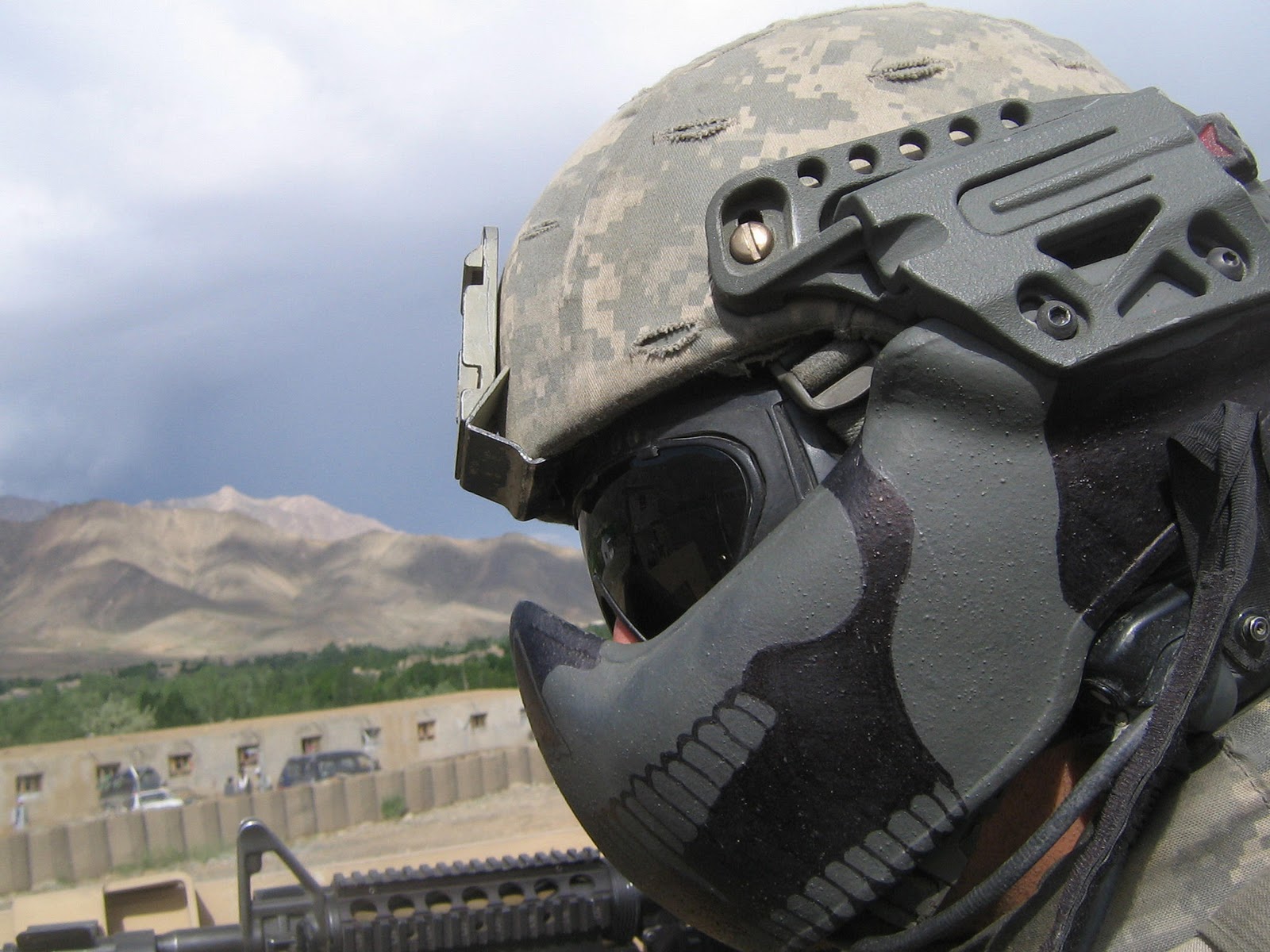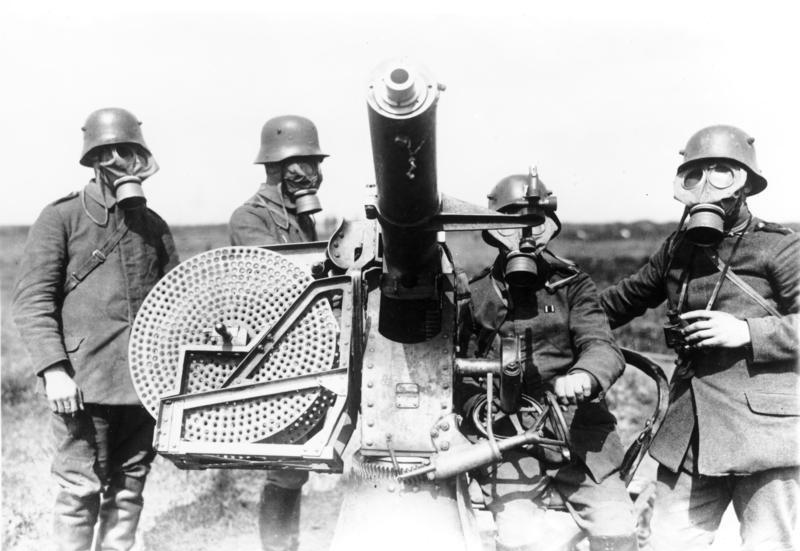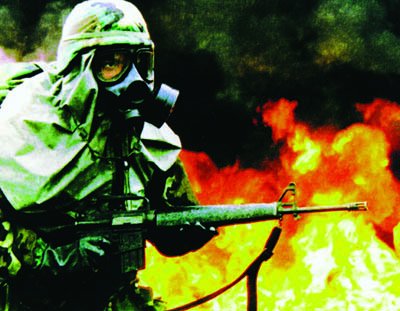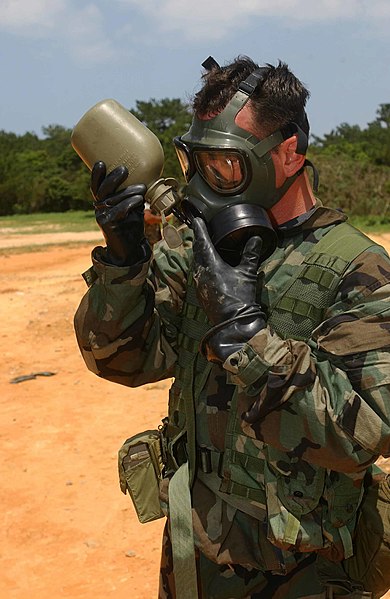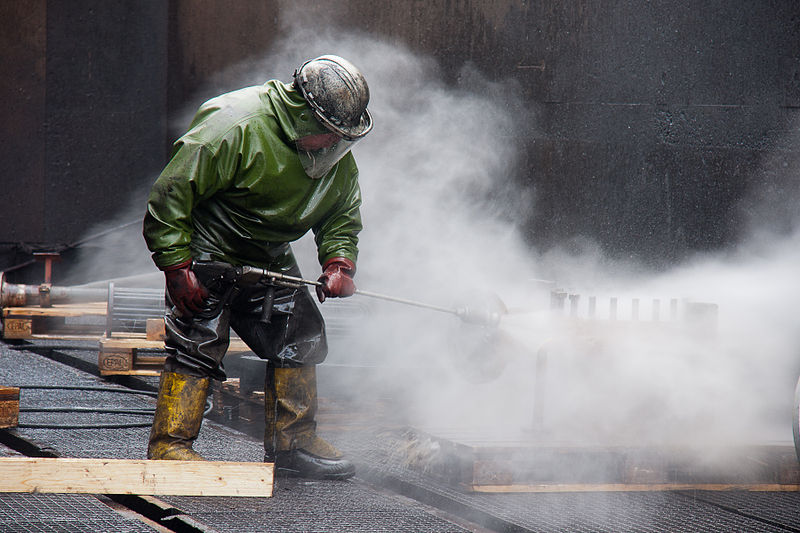Manticore
RETIRED MOD

- Joined
- Jan 18, 2009
- Messages
- 10,115
- Reaction score
- 114
- Country
- Location
A gas mask is a mask put on over the face to protect the wearer from inhaling airborne pollutants and toxic gases
Airborne toxic materials may be gaseous (for example the chlorine gas used in World War I) or particulate (such as many biological agents developed for weapons such as bacteria, viruses and toxins). Many gas masks include protection from both types. Gas masks are used in construction to protect against welding fumes, in deconstruction to protect against asbestos or other hazardous particles, and in the chemical industry when handling hazardous materials, as in making repairs to leaking equipment or cleaning after spills; workers are usually issued gas masks as a precaution against leaks.
During riots where tear gas or CS-gas is employed by riot police, gas masks are commonly used by police and rioters alike. Aside from serving their functional purposes, gas masks are also used as emblems in industrial music, by graffiti taggers because the mask protects them from the graffiti canister's toxic fumes, and by Urban Explorers venturing into environments where hazardous materials, such as asbestos, may be present.
The traditional gas mask style with two small circular eye windows originated when the only suitable material for these eye windows was glass or acrylic; as glass is notoriously brittle, glass eye windows had to be kept small and thick. Later, discovery of polycarbonate allowed gas masks with a big full-face window. Some have one or two filters attached to the face piece; others have a large filter connected to the face piece by a hose.
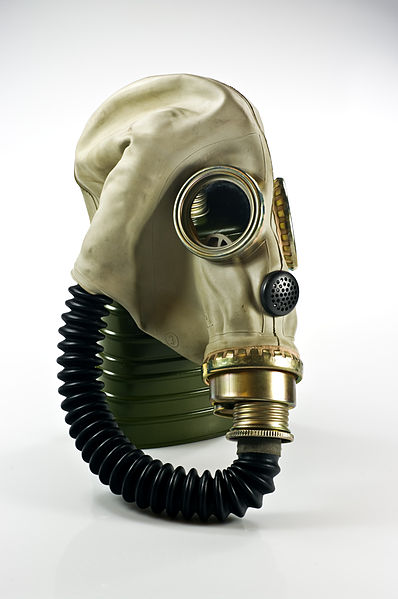
A 1970s/1980s type gas mask
Filter classification
The filter is selected according to the toxic compound.[2] Each filter type protects against a particular hazard:
AX - Low-boiling (≤65 °C) organic compounds
A - High-boiling (>65 °C) organic compounds
B - Inorganic gases (hydrogen sulfide, chlorine, hydrogen cyanide)
E - Sulfur dioxide and hydrogen chloride (acidic gases)
K - Ammonia and amines
CO - Carbon monoxide
Hg - Mercury
Reactor - Iodine and methyl iodide (radioactive)
P - Particles; classified as P1, P2, and P3 according to removal efficiency
ABEK, ABEK-P3, ABEK-HgP3 or other combination filters against multiple hazards
Particle filters are often included, because in many cases, the hazardous materials are in the form of mist, which is captured already by the particle filter before entering the chemical adsorber. Filtration may be aided with an air pump to improve wearer comfort. Filtration of air is only possible if there is sufficient oxygen in the first place. Thus, when handling asphyxiants, or when ventilation is poor or the hazards are unknown, filtration is not possible and air must be supplied from a pressurized bottle as in scuba diving. Also, a gas mask does not protect against other hazards; for example, corrosive gases can damage the skin, requiring full-body protection.
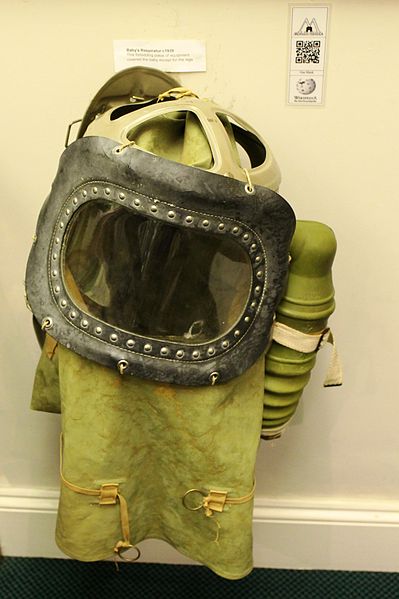
A 1939 Second World War-era baby's gas mask in Monmouth Regimental Museum. This design covered the whole of the baby except for its legs.


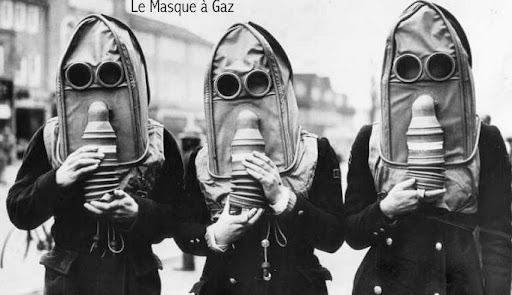


Modern chemical warfare began on April 22, 1915, when German soldiers first used chlorine gas to attack the French in Ypres, against Canadian and French colonial troops. The initial response was to equip troops with cotton mouth pads for protection. Soon afterwards the British added a long cloth which was used to tie chemical-soaked mouth pads into place, and which was called the Black Veil Respirator. Dr. Cluny MacPherson of The Royal Newfoundland Regiment brought the idea of a mask made of chemical absorbing fabric and which fitted over the entire head to England, and this was developed into the British Hypo Helmet of June 1915. This primitive type of mask went through several stages of development before being superseded in 1916 by the canister gas mask of 1916. This had a mask connected to a tin can containing the absorbent materials by a hose.
But the inventor of the first effective coal gas mask was Russian scientist Nikolay Dimitrievich Zelinskiy in World War I (in 1915) against German gas attacks. In 1916 his gas masks were accepted on arms of the countries of Triple Entente. Zelinskiy gas mask is the most popular in the world.

Gas masks development since has mirrored the development of chemical agents in warfare, filling the need to protect against ever more deadly threats, biological weapons, and radioactive dust in the nuclear era. However, where agents that cause harm through contact or penetration of the skin occurs, such as blister agent or nerve agent, a gas mask alone is not sufficient protection, and full protective clothing must be worn in addition, to protect from contact with the atmosphere. For reasons of civil defense and personal protection, individuals often purchase gas masks in the belief that they prevent against the harmful effects of an attack with nuclear, biological, or chemical (NBC) agents; this is not the case, as gas masks protect only against respiratory absorption. Whilst most military gas masks are designed to be capable of protection against spectrum of NBC agents, they can be coupled with filter canisters that are proof against those agents (heavier) or just against riot control agents and smoke (lighter, and often used for training purposes); likewise there are lightweight masks solely for use in riot control agents and not for NBC situations.
Although thorough training and the availability of gas masks and other protective equipment can render the casualty-causing effects of an attack by chemical agents nullified, troops who are forced to operate in full protective gear are less efficient in completing their given tasks, tire easily, and may be affected psychologically by the threat of attack by these weapons. During the Cold War era, it was seen as inevitable that there would be a constant NBC threat on the battlefield, and thus troops needed protection in which they could remain fully functional; thus protective gear, and especially gas masks have evolved to incorporate innovations in terms of increasing user-comfort, and in compatibility with other equipment (from drinking devices to artificial respiration tubes, to communications systems etc). The gas mask has thus now arrived at a 'fourth generation' of development. Learn more about the development of military gas masks throughout history.
Airborne toxic materials may be gaseous (for example the chlorine gas used in World War I) or particulate (such as many biological agents developed for weapons such as bacteria, viruses and toxins). Many gas masks include protection from both types. Gas masks are used in construction to protect against welding fumes, in deconstruction to protect against asbestos or other hazardous particles, and in the chemical industry when handling hazardous materials, as in making repairs to leaking equipment or cleaning after spills; workers are usually issued gas masks as a precaution against leaks.
During riots where tear gas or CS-gas is employed by riot police, gas masks are commonly used by police and rioters alike. Aside from serving their functional purposes, gas masks are also used as emblems in industrial music, by graffiti taggers because the mask protects them from the graffiti canister's toxic fumes, and by Urban Explorers venturing into environments where hazardous materials, such as asbestos, may be present.
The traditional gas mask style with two small circular eye windows originated when the only suitable material for these eye windows was glass or acrylic; as glass is notoriously brittle, glass eye windows had to be kept small and thick. Later, discovery of polycarbonate allowed gas masks with a big full-face window. Some have one or two filters attached to the face piece; others have a large filter connected to the face piece by a hose.

A 1970s/1980s type gas mask
Filter classification
The filter is selected according to the toxic compound.[2] Each filter type protects against a particular hazard:
AX - Low-boiling (≤65 °C) organic compounds
A - High-boiling (>65 °C) organic compounds
B - Inorganic gases (hydrogen sulfide, chlorine, hydrogen cyanide)
E - Sulfur dioxide and hydrogen chloride (acidic gases)
K - Ammonia and amines
CO - Carbon monoxide
Hg - Mercury
Reactor - Iodine and methyl iodide (radioactive)
P - Particles; classified as P1, P2, and P3 according to removal efficiency
ABEK, ABEK-P3, ABEK-HgP3 or other combination filters against multiple hazards
Particle filters are often included, because in many cases, the hazardous materials are in the form of mist, which is captured already by the particle filter before entering the chemical adsorber. Filtration may be aided with an air pump to improve wearer comfort. Filtration of air is only possible if there is sufficient oxygen in the first place. Thus, when handling asphyxiants, or when ventilation is poor or the hazards are unknown, filtration is not possible and air must be supplied from a pressurized bottle as in scuba diving. Also, a gas mask does not protect against other hazards; for example, corrosive gases can damage the skin, requiring full-body protection.
A 1939 Second World War-era baby's gas mask in Monmouth Regimental Museum. This design covered the whole of the baby except for its legs.





Modern chemical warfare began on April 22, 1915, when German soldiers first used chlorine gas to attack the French in Ypres, against Canadian and French colonial troops. The initial response was to equip troops with cotton mouth pads for protection. Soon afterwards the British added a long cloth which was used to tie chemical-soaked mouth pads into place, and which was called the Black Veil Respirator. Dr. Cluny MacPherson of The Royal Newfoundland Regiment brought the idea of a mask made of chemical absorbing fabric and which fitted over the entire head to England, and this was developed into the British Hypo Helmet of June 1915. This primitive type of mask went through several stages of development before being superseded in 1916 by the canister gas mask of 1916. This had a mask connected to a tin can containing the absorbent materials by a hose.
But the inventor of the first effective coal gas mask was Russian scientist Nikolay Dimitrievich Zelinskiy in World War I (in 1915) against German gas attacks. In 1916 his gas masks were accepted on arms of the countries of Triple Entente. Zelinskiy gas mask is the most popular in the world.

Gas masks development since has mirrored the development of chemical agents in warfare, filling the need to protect against ever more deadly threats, biological weapons, and radioactive dust in the nuclear era. However, where agents that cause harm through contact or penetration of the skin occurs, such as blister agent or nerve agent, a gas mask alone is not sufficient protection, and full protective clothing must be worn in addition, to protect from contact with the atmosphere. For reasons of civil defense and personal protection, individuals often purchase gas masks in the belief that they prevent against the harmful effects of an attack with nuclear, biological, or chemical (NBC) agents; this is not the case, as gas masks protect only against respiratory absorption. Whilst most military gas masks are designed to be capable of protection against spectrum of NBC agents, they can be coupled with filter canisters that are proof against those agents (heavier) or just against riot control agents and smoke (lighter, and often used for training purposes); likewise there are lightweight masks solely for use in riot control agents and not for NBC situations.
Although thorough training and the availability of gas masks and other protective equipment can render the casualty-causing effects of an attack by chemical agents nullified, troops who are forced to operate in full protective gear are less efficient in completing their given tasks, tire easily, and may be affected psychologically by the threat of attack by these weapons. During the Cold War era, it was seen as inevitable that there would be a constant NBC threat on the battlefield, and thus troops needed protection in which they could remain fully functional; thus protective gear, and especially gas masks have evolved to incorporate innovations in terms of increasing user-comfort, and in compatibility with other equipment (from drinking devices to artificial respiration tubes, to communications systems etc). The gas mask has thus now arrived at a 'fourth generation' of development. Learn more about the development of military gas masks throughout history.



